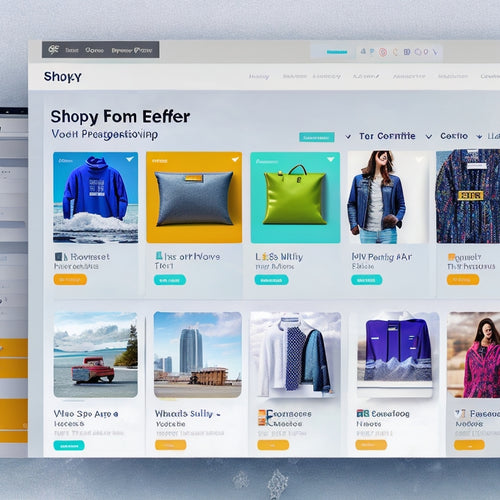
Ecommerce Course Pricing Strategies for Success
Share
You're about to create a profitable ecommerce course, but you're stuck on pricing. That's because you know it's not just about slapping a number on your product. To succeed, you need a strategy that resonates with your target audience and sets you apart from competitors. Start by understanding your audience's pain points, goals, and motivations. Then, analyze your competitors' pricing strategies and identify gaps in the market. Next, focus on the unique benefits and results your course offers, and tailor your pricing to your audience. By doing so, you'll create a pricing plan that drives sales and boosts revenue - and that's just the beginning.
Key Takeaways
• Develop a deep understanding of your target audience's pain points, goals, and motivations to inform your pricing strategy.
• Analyze competitors' pricing strategies to identify gaps and opportunities in the market and create a unique selling proposition.
• Focus on the unique benefits and results your course offers to justify premium pricing and differentiate from competitors.
• Implement a tiered pricing approach to appeal to different customer segments, increase overall revenue, and maximize profit.
• Test and refine your pricing strategy over time based on customer feedback and market research to ensure optimal pricing.
Understanding Your Target Audience
When creating an ecommerce course, it's essential to put yourself in your target audience's shoes and pinpoint their pain points, goals, and motivations. You need to understand what drives them, what problems they're trying to solve, and what they hope to achieve from your course.
This is where customer segmentation comes in – identifying specific groups within your target market and tailoring your content to their unique needs. Through market research, you'll gather valuable insights into consumer behavior, preferences, and purchasing habits.
This information will help you develop a target market analysis, allowing you to create a course that resonates with your audience. By understanding your target audience, you'll be able to craft a compelling message, create relevant content, and ultimately, price your course effectively.
Pricing Strategies for Beginners
You're likely wondering how to price your ecommerce course, and as a beginner, it's essential to start with a strategy that balances your business goals with your customers' perceived value. A cost analysis is a great place to start, as it helps you determine the costs associated with creating and delivering your course. This includes development costs, marketing expenses, and any ongoing maintenance costs. Once you have a clear understanding of your costs, you can begin to think about price placement.
Price positioning refers to the strategic placement of your product within the market concerning price. Are you a premium offering, or a budget-friendly option? Where you position your course will greatly impact how customers perceive its value. As a beginner, it's often a good idea to start with a lower price point and adjust as needed. This allows you to test the market, gather feedback, and refine your pricing strategy over time.
Competitor-Based Pricing Analysis
Analyzing your competitors' pricing strategies can provide valuable insights into what customers are willing to pay for similar ecommerce courses, helping you inform your own pricing decisions. By conducting market research, you'll uncover the sweet spot that resonates with your target audience. You'll identify what works and what doesn't, allowing you to make informed pricing adjustments.
In your competitor analysis, examine the pricing strategies of at least three to five similar ecommerce courses. Note the prices they charge, the value they offer, and the target audience they're catering to. Identify gaps in the market that you can capitalize on. You might find that your competitors are underserving a particular segment or neglecting a key feature.
This knowledge will enable you to refine your pricing strategy and create a unique selling proposition that sets you apart. By understanding your competitors' strengths and weaknesses, you'll be better equipped to position your ecommerce course as a superior offering, justifying premium pricing or competitive pricing that drives sales.
Value-Based Pricing for Ecommerce
By focusing on the unique benefits and results your ecommerce course delivers to students, you can set prices that accurately reflect its value in the market. This value-based pricing strategy allows you to differentiate your course from competitors and charge a premium.
To implement this strategy, you need to understand your target audience's needs, desires, and pain points. Conduct customer segmentation to identify your ideal customer and tailor your pricing accordingly. For instance, if your course is designed for entrepreneurs, you may charge a higher price for advanced features that cater to their specific needs.
Pricing psychology also plays a pivotal role in value-based pricing. You need to understand how your customers perceive value and how they make purchasing decisions. For example, if your course offers a unique feature that solves a specific problem, you can charge a higher price for it.
Additionally, consider offering a free trial or demo to allow customers to experience the value of your course firsthand. By doing so, you can build trust and credibility, leading to higher conversion rates and increased revenue. By focusing on the value your course delivers, you can set prices that reflect its true worth and maximize your profits.
Tiered Pricing for Maximum Profit
When structuring your ecommerce course pricing, a tiered approach can help you capture maximum profit by offering varying levels of access to your content, each tailored to a specific customer segment's needs and willingness to pay. This strategy leverages pricing psychology, allowing you to tap into different customer segments' perceived value of your course. By creating distinct pricing tiers, you can appeal to a broader range of customers, increasing overall revenue.
To optimize your tiered pricing model, consider the following: start with a basic tier that provides essential content at a lower price point, appealing to budget-conscious customers.
Then, offer a mid-tier package that adds additional resources or support, targeting customers willing to pay more for enhanced value.
Dynamic Pricing for Peak Sales
As you tailor your ecommerce course pricing strategy, consider harnessing the power of dynamic pricing to capitalize on peak sales periods, adjusting your prices in real-time to maximize revenue and stay ahead of the competition.
This approach allows you to respond quickly to changes in demand, making real-time adjustments to optimize your pricing and stay competitive. By leveraging data-driven insights, you can accurately forecast demand and adjust your prices accordingly, ensuring you're always charging the best amount.
Dynamic pricing also enables you to take advantage of pricing elasticity, where small changes in price can greatly impact demand. By understanding how your customers respond to different price points, you can fine-tune your pricing strategy to drive more sales and revenue.
Additionally, dynamic pricing allows you to adapt to changes in the market, seasonality, and other external factors that can impact demand. By staying agile and responsive, you can stay ahead of the competition and maximize your revenue during peak sales periods.
Frequently Asked Questions
How Often Should I Adjust My Ecommerce Pricing Strategy?
You should adjust your pricing strategy regularly, balancing pricing consistency with customer feedback, while staying on top of market trends and competitor analysis to guarantee you're competitive and profitable.
Can I Use Pricing Strategies for Both Physical and Digital Products?
You're the master chef, blending ingredients to perfect your pricing recipe! Yes, you can use pricing strategies for both physical and digital products by leveraging product differentiation, customer segmentation, competitive analysis, and market research to serve up a winning combination.
How Do I Handle Price Changes for Loyal or Repeat Customers?
'When adjusting prices, you'll want to factor in customer retention by offering loyal customers exclusive discounts or incentives through loyalty programs, ensuring they feel valued and appreciated, and maintaining their loyalty despite changes.'
Are There Any Legal Considerations for Ecommerce Pricing Strategies?
'When in doubt, throw it out' - make sure you're aware of legal considerations. You must comply with regulatory requirements, maintaining pricing transparency to avoid lawsuits and reputational damage, so research and understand the rules governing your ecommerce business.
Can I Use AI Tools to Optimize My Ecommerce Pricing Strategy?
You can leverage AI pricing tools to optimize your strategy, automating tasks like competitive analysis, demand forecasting, and price adjustments, allowing you to respond quickly to market changes and stay ahead of the competition.
Related Posts
-
Enhance Your Shopify Store With Powerful Product Video Apps
In today's digital landscape, incorporating product videos into Shopify stores has become increasingly essential for ...
-

Build Online Courses for Free With These Tools
You can create high-quality online courses without breaking the bank. Start with user-friendly platforms like Udemy, ...
-

What Is App Integration in Shopify
App integration in Shopify refers to the process of incorporating external applications into the Shopify platform to...

